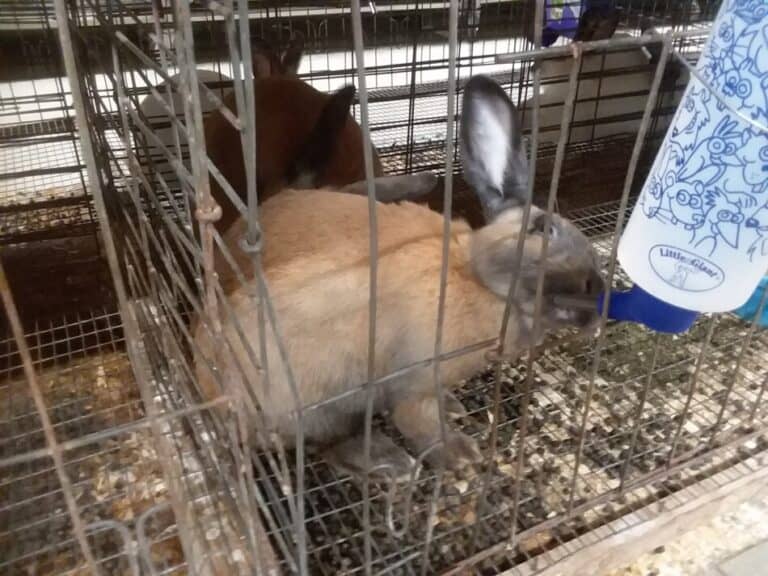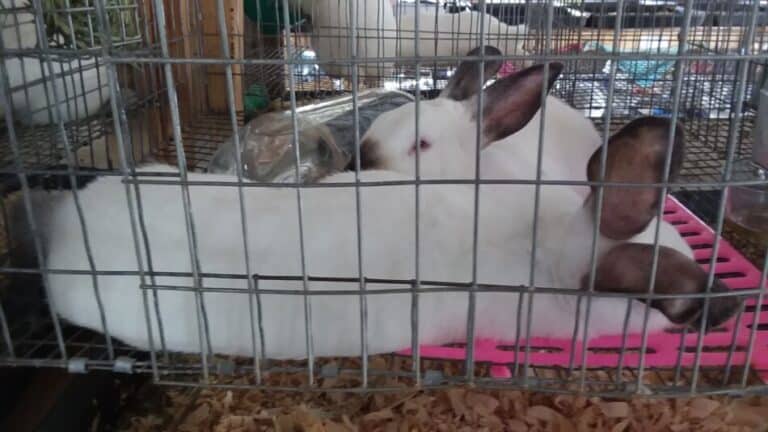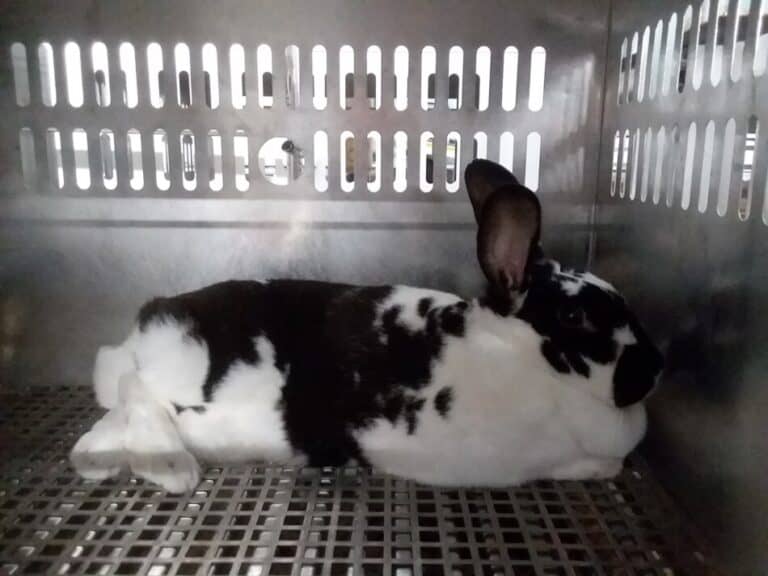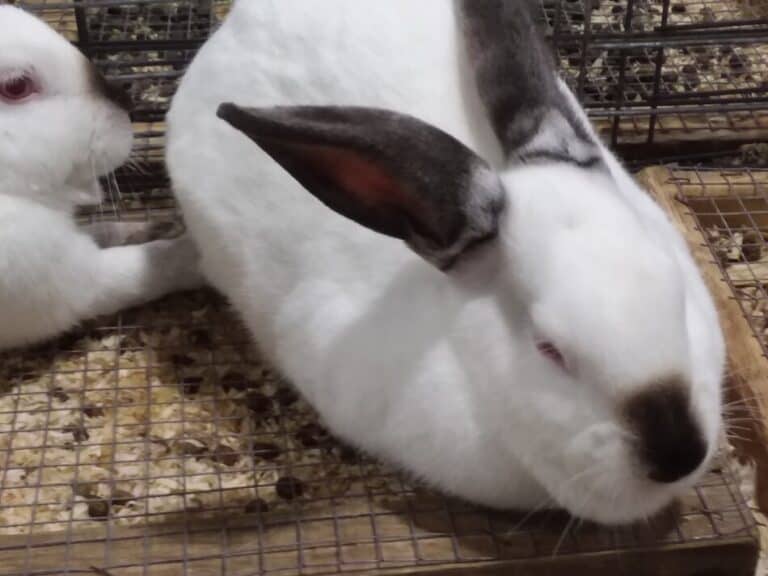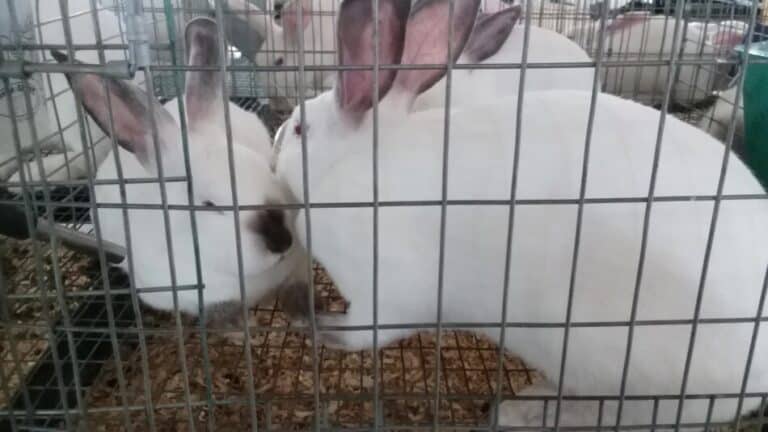How Much Are Rabbits And Cost To Raise Them
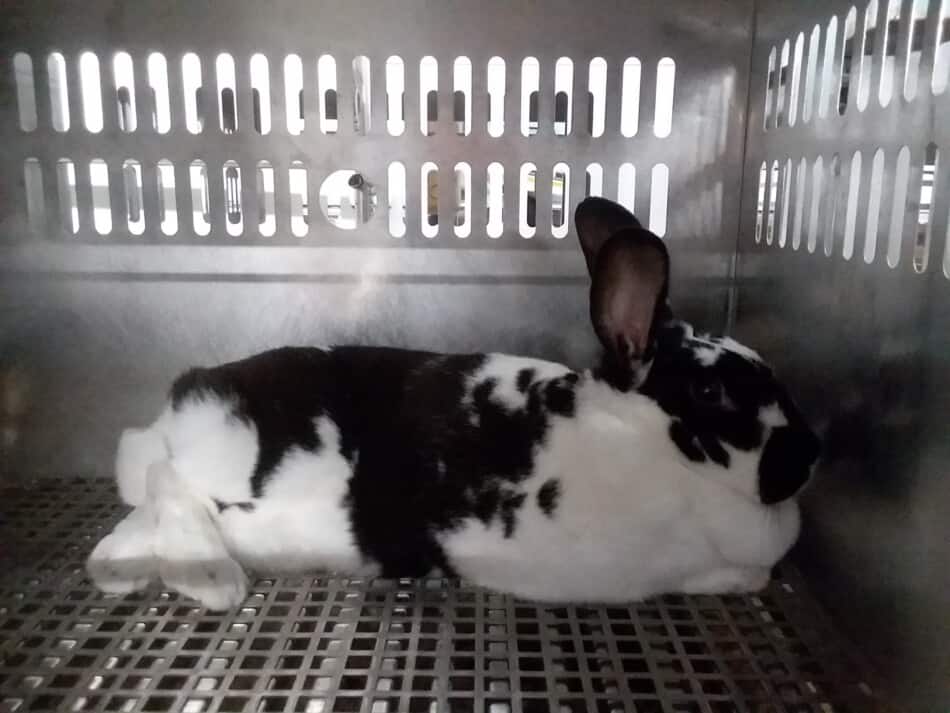
Meat rabbits are finally becoming more of a popular animal and for good reason! Not too many other animals are family friendly and can be comfortably raise in even the smallest backyard!
Now, to the big questions: what is the cost of getting into meat rabbits and what will it cost you to raise them?
Breeding stock quality rabbits cost between $25-80 each, with exceptionally productive individuals, unusual breeds and show stock on the higher end of the range. Fryers (young meat rabbits) $6-6.80 each to raise to 5 pounds.
| Rabbit | Cost | Key points |
| Proven breeding stock | $50-80 each | most reliable producer hard to find |
| Breeding age rabbits | $40-60 | ready to produce production ability varies with individual |
| Junior rabbits | $20-30 | less expensive way to start months from breeding age and size |
| Fryers | $10-20 | cheapest way to get rabbits furthest from being productive |
We’ll go over the rabbits you should buy, from the best breeds to choose for meat rabbits, including the advantages and disadvantages of different ages of breeding stock, and get into the costs of feeding your rabbits.
Is Raising Rabbits For Meat Worth It? is an article I wrote to help you compare raising your own meat rabbits to buying rabbit meat from a farmer, which will help you put a value on the meat you raise for yourself.
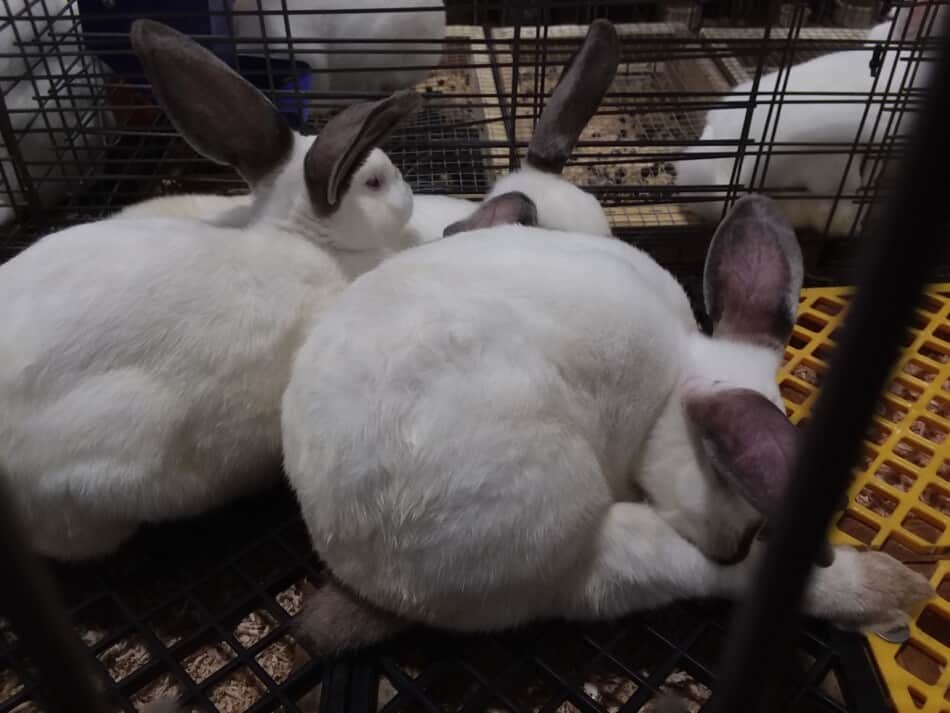
Cost to buy a rabbit is $25-80
How Much Meat From A Pair Of Meat Rabbits goes over how to calculate the amount of meat you will get from one pair of rabbits, depending upon when and how often you breed them.
The cost to buy adult breeding stock quality rabbits is going to be anywhere from $25-80 each for a high quality commercial meat rabbit.
Of course, special breeds, especially breeds that are hard to find in your area, breeds that are surging in popularity and potential show stock can cost significantly more.
It is most common to buy a breeding trio, which is one buck and two does. If you have done the math and need more production, consider an extended trio, which is one buck and three does.
How Many Rabbits Do You Need? shows you how to calculate the number of adults you need based on fryer production.
Buying proven adult breeding stock
Pros: great choices for starting your rabbitry, full size so you know structure and meatiness with proven reproductive ability
Cons: hard to find and will be higher cost
Ideally, you will be buying proven breeding stock. By proven, I mean rabbits that have had a litter or two and have proven that they are good moms or good breeders, in the case of the buck.
Rabbits in this group are going to be the highest cost and the hardest to get a hold of, but I mention them to make sure you know that if rabbits like these come up for sale, this is the best group to buy.
Expect to pay on the higher end of what rabbits normally sell for in your area for a trio of breeding rabbits in this group. Proven rabbits are going to be $50-80 each. Rare or unusual breeds will be more.
The reason I say “ideally” is because these are rabbits that are at their peak value, have a known temperament and raising litters right now, so the breeder is less likely to want to part with them than rabbits that are not productive yet.
If you can, get proven stock, if you can’t, just get ready to breed breeding stock.
There are occasional opportunities: all breeders will eventually run out of space, want to take their breeding program in a different direction or just want to downsize the rabbitry. This is a golden opportunity for you, take advantage of it!
In each of these situations, proven rabbits will be available to buyers that the breeder would normally keep, but has decided to sell. If you happen across something like this, consider yourself lucky and get some great rabbits!
ARBA Recognized Breeds is a quick to read list of each breed with links to the supporting organization that you can contact to get in touch with rabbit breeders that may have breeding stock for sale.
Of course, you do not need to get registered rabbits, but you should at least look around on ARBA’s site and get familiar with the shape and key characteristics of high quality rabbits.
Buying adult ready to breed breeding stock rabbits
Pros: ready to produce litters for you, full size so you don’t have to guess at structure or meatiness
Cons: no track record individually, in the higher price range for rabbits
I have to admit, it is much more likely that you will be able to get rabbits in this category, ready to breed but have not produced a litter. These rabbits will also be on the higher end of the price range in your area.
I would expect to pay $40-60 each for rabbits that are high quality, ready to breed rabbits since these guys will get you started producing litters right away.
These rabbits should be from high quality parents with a great track record as parents, making it more likely the rabbits you buy will also be great parents. Of course, you don’t know for sure, but a good family track record is a good start.
Buying half grown (junior) breeding stock
Pros: less money to purchase, gives you time to get used to owning and working with rabbits before adding in the additional management needs of breeding
Cons: will not be productive for a few months, unknown how they will look as adults, since they are still growing
It is much more likely that you will be able to get rabbits from this junior age group, potential breeding stock rabbits that have been kept back to see how they grow but are still a few months from breeding age and size.
Rabbits in this age group are probably going to be in the 3-6 month old range, so smaller than adults but bigger than fryers. I would expect to pay $20-30 each for these rabbits.
Chances are this is the group that the breeder herself has selected her keepers out of and is offering the rest of the group of good, well grown junior rabbits for sale.
This is a great group of rabbits for you to start with, since they were selected as potential breeding stock. This group will be a bit older than fryers, so you’ll have more of an idea of their growth and conformation, as adults.
Buying weaned fryers to keep for breeding
Pros: easy to find, least expensive way to get started with raising meat rabbits
Cons: it will be a long time until these rabbits are productive and you do not know their suitability as breeding stock, you can only guess
Weaned rabbits, also called fryers, are the youngest group of rabbit that are likely to be available for you to buy. These are kits that are eating well on their own and would be the least expensive.
I would expect to pay $10-20 for rabbits in this group. In my area, Ohio, I have seen a few special breeds advertised for $25 per fryer, but that is because of the unusual breed, which was Champagne D’Argent.
The reason fryers are the least expensive is that they are also the furthest from being productive and you can not tell what their build or temperament will be as adults, since they have quite a bit of growing yet to do.
Don’t get cheap rabbits!
If there is a section here that deserves “red alert” status, this is it: do not get cheap rabbits! I’m not suggesting looking for outrageously expensive breeding stock rabbits, but I am definitely saying steer clear of cheap.
Buying cheap breeding stock seems like a way to get ahead, but it is actually the best way to set yourself and your rabbitry on a collision course with disaster. No joke, cheap is never a good idea.
Quality pays, actually quality pays repeatedly. Get good stock to begin with, since all of your future rabbits will come from these. Growth and carcass traits are genetic. To get good results you have to start with good genetics.
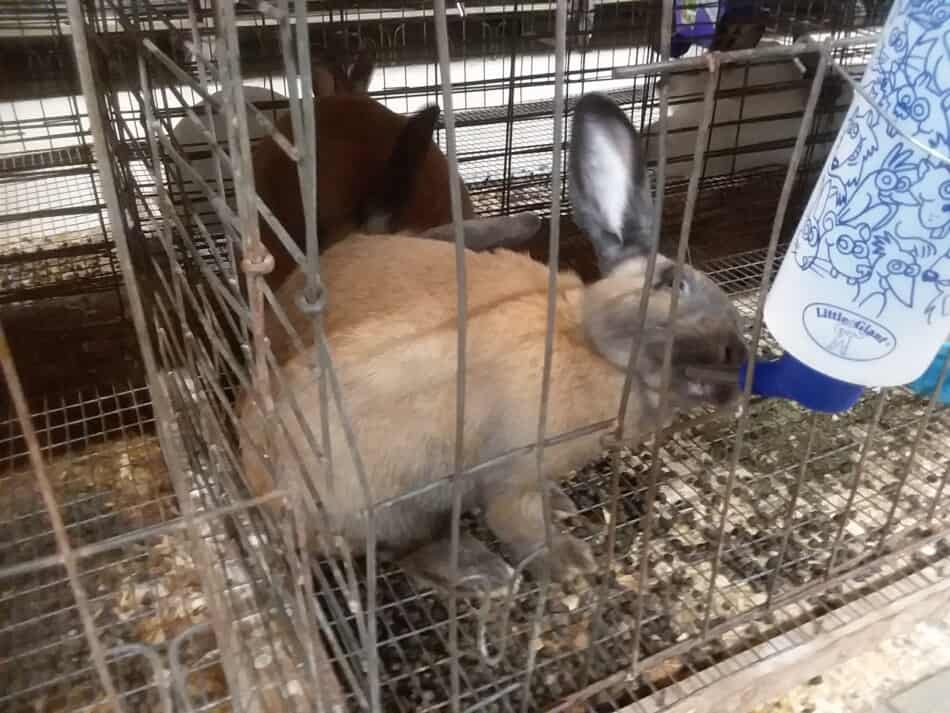
Get meat rabbit genetics
The other mistake new folks make is thinking that any rabbit will work well as a meat rabbit. Close, but not quite.
Any rabbit can be used as a meat rabbit, of course. But for your rabbits to perform well, now that’s the result of management, good breeding stock and selection for carcass traits. It doesn’t happen by accident!
16 Breeds Of Rabbits For Meat gives you some options for your meat rabbit breed selection. The best performance, growth wise, will come from high quality Californian or New Zealand White rabbits.
Get meat rabbits that are bred to be meat rabbits. None of the other breeds will perform as meat producers as well as the meat breeds, easy examples of which are Californian and New Zealand White, the meat rabbit all stars.
If you want a bit more color in your rabbitry, you can branch out slightly to New Zealand Red, Blue, Black or Broken or another meat breed like Cinnamon or Palomino, but keep it to a meat breed for results that you will be happy with.
Can you use any breed of rabbit you want? Sure, but you’ll get not so great to very poor results depending upon what rabbits you are working with. Just go with one of the more common meat breed rabbits to start with.
Rabbit housing can be cages or hutches
The housing needs of your rabbits are pretty simple. You can get started with all new equipment (wire cages, feeders and waterers) for a trio for about $350, read Meat Rabbits Worth It for the specifics here.
Alternatively, you can go the used route and pick up hutches and cages as they become available in your area.
This is a great way to get started for less costs, but will be much more of a hit or miss opportunity since you never know when these deals will become available.
How To Start Raising Meat Rabbits goes over the basics you need to get started with raising your own meat rabbits.
You should have cages with wire floors
If at all possible, go with wire floor rabbit cages. The thicker the wire the better. With wire floors, the manure pellets and the urine drop through the mesh, which keeps the rabbit’s feet and underside clean.
If you feel that your rabbits need a more foot friendly flooring material than wire, consider getting a resting board for each cage. These are wide mesh plastic mats that give the rabbit time off the wire, yet still keep the cage clean.
Avoid wooden floors, if you can. Here’s why: when the rabbit pees the urine runs along the boards, creating a wet spot that the rabbit has to walk through to get to the other side of the cage. Not great.
The other down side of wooden floors is that the urine will soak into the wood and make the cage smell, not great either, especially on warmer days! Go with a sturdy wire cage or hutch floor, instead.
Feed your rabbits pelleted feed
The easiest way to feed rabbits is to give them pellets.
Shop around for a high quality pelleted feed, not the cheapest. I made that mistake once, I bought the generic store brand rabbit feed, yikes! They hated it and I wasted my money. Double yikes.
Feed is an important aspect of raising rabbits because it accounts for about 75 percent of your production costs.
https://www.canr.msu.edu/resources/rabbit_tracks_feeds_and_feeding
Buy a name brand feed that is formulated for your rabbits at their growth stage. This means that young rabbits and does will need a different feed than bucks or juniors that you are keeping as replacements.
If you keep everyone on the same feed, the lower energy needs rabbits, in this case the buck and the replacements, will get fat. This is a big problem because fat rabbits do not reproduce well, and that’s the whole point of this group!
But, if you keep high energy needs rabbits like nursing moms or younger fryers on a maintenance rabbit diet, they will not get the energy they need to perform well and their health will suffer.
Rabbit Tracks: Feeds and Feeding is a nice overview of rabbit feeding from Michigan State University.
Creative feeding will slow growth
Anytime you move your rabbits from a pelleted feed to other feed sources, you will see a reduction in growth rate. This is fine, as long as you are aware of it.
The occasional snack, like a very small handful of nice hay once in a while, is fine. But to have all they can eat hay in their cage will result in slower growth.
Cost to raise a fryer to 5 pounds is $6-6.80
The cost to raise fryers to 5 pounds is $6-6.8 based on a 3:1 feed to gain ratio and $0.40-0.44 per pound feed costs.
Not so surprisingly, if you have a more expensive feed, your rabbits are going to cost more to finish out. The feed costs I used here are 50 pound bags of feed at TSC, at $20-22 per bag. Small bags are outrageously priced, don’t buy those.
If you decide to go with an alternative feeding plan, for instance providing lots of hay or going with fresh greens, you will also have an altered finishing time for your fryers.
Since these feedstuffs are lower in energy than pellets, the fryers will take longer to reach 5 pounds than fryers on the pellets only diet.
As to whether or not you end up saving money by feeding alternative feeds, I don’t know. Why? Because as a rabbit gets older it also gets more inefficient in growth. These fryers will take longer to grow they will also take more feed.
Does that pay for your situation? It depends upon what is most important to you. If you want lowest cash expenditure, it probably does pay to use all of the non pelleted feeds your rabbits can safely consume.
If your main purpose is growth, stick to a pelleted feed and get those fryers growing and finishing quicker.
Count the cost of feeding the breeding stock rabbits, too
An additional point that most new folks don’t think of: cost of feeding the breeding stock.
Since you are producing fryers, it’s common to just count the cost of feeding the fryers. If you really want to have an accurate picture of costs, you also need to take into account the cost of feeding the rest of the breeding stock, as well.
Generally, the easiest way to figure feed costs for the entire rabbitry is to use a 4:1 ratio for your fryers. You are counting 3 pounds for the fryer and one pound for another adult rabbit, per pound of gain for the fryer.
The costs for the entire rabbitry will be another few dollars per fryer, taking the feed cost per fryer from $6-6.60 up to $8-8.80 each.
Obviously, this is not super accurate, since the exact costs for you will depend upon how many non productive rabbits you are currently feeding, but gives you a place to start.
If you have a ton or replacements that you are raising, then your rabbitry feed cost will be higher and your feed efficiency will be lower, since you have a lot of eaters that are not yet producers.
If you just have a trio and put all the fryers in the freezer, then your feed to gain will be at the most efficient, since you will have no rabbits that are eating yet no producing.
